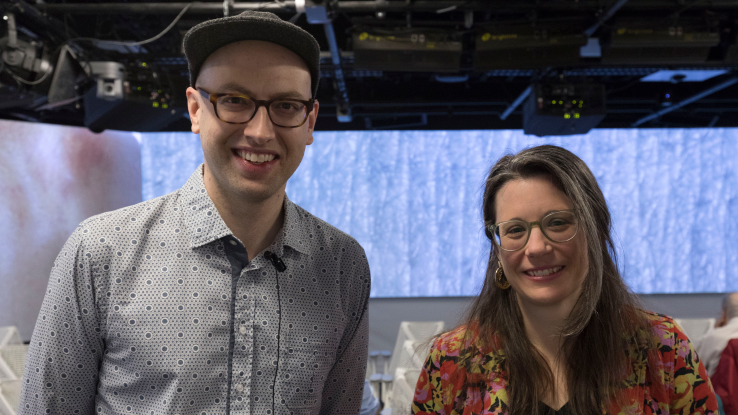
Immersive Scholar resident project heading to China

“Surface Tension,” an immersive visual work created by the artist duo Caitlin & Misha during their 2019 Immersive Scholar residency at the Libraries, has been selected for exhibition at China VISAP.
The ChinaVis 2021 Arts Program, or China VISAP'21, showcases innovative artwork and research that explores intersections between art, design and visualization. Taking place in July in Wuhan, China, the program aims to foster new thinking, discussion and collaboration between artists, designers, technologists, visualization scientists and others working at the intersection of these fields.
These goals and ideals are shared by the Libraries’ Immersive Scholar program. Hosting numerous residents over several years, the program is part of an Andrew W. Mellon Foundation project grant to continue the Libraries’ pioneering work with large-scale, research visualization technologies and to support the advancement of tools and techniques for developing and sharing such visual content for research. This is the first residency project from the Libraries’ Immersive Scholar program to be exhibited internationally.
Caitlin & Misha is Caitlin Foley and Misha Rabinovich, two artists based in the Boston area who spent three months in spring 2019 at the Hunt Library. They worked with the Libraries and other campus partners to create “Surface Tension,” which appeared on the Hunt Library’s large-scale digital walls, including the Art Wall, the iPearl Immersion Theater, the Commons Wall, and the Visualization Wall.
“Surface Tension”uses daily data from the United States Geological Survey (USGS) to create fluid, kinetic animations. Caitlin & Misha describe the artwork saying, “The movement (blobs) in ‘Surface Tension’ are the data points for the percentile column for the date on which you are viewing it. All of the surface water on Earth is interconnected, and the disturbances at the specific points ripple out and interfere with each other, influencing each other and combining into an aggregate pattern of interdependence.” The artists hope that the work makes viewers more aware of the systems—both human and ecological—involved in the availability of and access to drinking water. They also hope that unconsidered metaphors about water as blue and beautiful and pure will be problematized through their usage of data that reflects inequities in freshwater access.